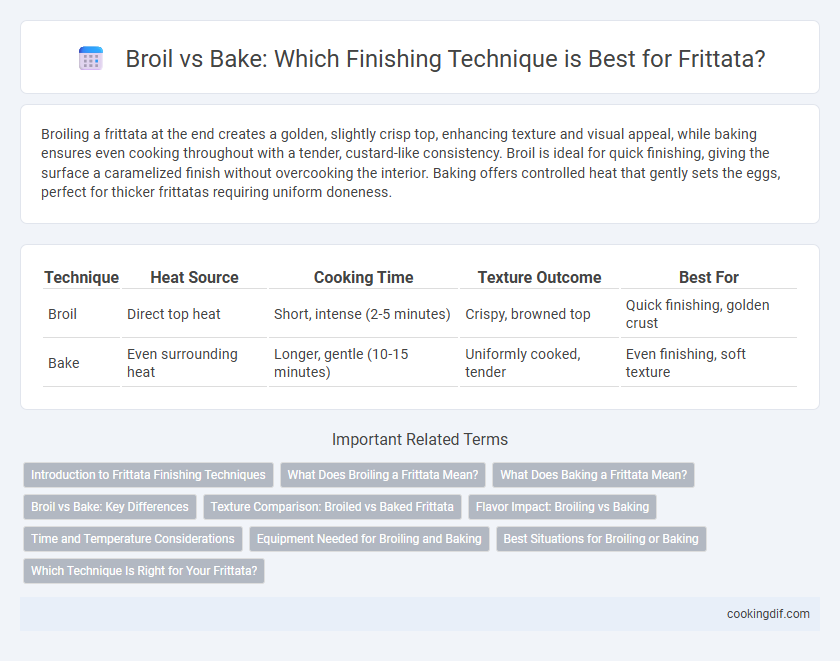Broiling a frittata at the end creates a golden, slightly crisp top, enhancing texture and visual appeal, while baking ensures even cooking throughout with a tender, custard-like consistency. Broil is ideal for quick finishing, giving the surface a caramelized finish without overcooking the interior. Baking offers controlled heat that gently sets the eggs, perfect for thicker frittatas requiring uniform doneness.
Table of Comparison
| Technique | Heat Source | Cooking Time | Texture Outcome | Best For |
|---|---|---|---|---|
| Broil | Direct top heat | Short, intense (2-5 minutes) | Crispy, browned top | Quick finishing, golden crust |
| Bake | Even surrounding heat | Longer, gentle (10-15 minutes) | Uniformly cooked, tender | Even finishing, soft texture |
Introduction to Frittata Finishing Techniques
Broiling a frittata provides a high-heat, direct cooking method that quickly browns and crisps the top layer, enhancing texture and flavor. Baking, in contrast, offers more even, gentle heat ideal for thorough cooking without over-browning, ensuring a tender and uniformly set frittata. Understanding the differences between broil and bake techniques allows for precise control over the final appearance and mouthfeel of the dish.
What Does Broiling a Frittata Mean?
Broiling a frittata means exposing it to high direct heat from above to quickly brown and crisp the top layer without overcooking the interior. This finishing technique uses the broiler setting in an oven, which produces intense radiant heat that caramelizes cheese and ingredients on the surface. Broiling helps achieve a golden, slightly charred finish that enhances both texture and flavor.
What Does Baking a Frittata Mean?
Baking a frittata means cooking the eggs evenly in a moderate oven temperature, allowing the mixture to set gently without browning too quickly. This method ensures a tender, custard-like texture throughout the frittata while fully cooking the additions like vegetables and cheese. Compared to broiling, baking provides consistent heat, preventing the top from burning before the inside is cooked.
Broil vs Bake: Key Differences
Broiling exposes the frittata to direct high heat from above, resulting in a quicker, browned, and crispy top layer, perfect for a golden finish. Baking cooks the frittata evenly throughout using surrounding hot air, producing a tender, uniformly set texture without intense browning. Choosing broil versus bake impacts cooking time, texture, and visual appeal, with broil offering speed and a crispy top while bake ensures thorough, gentle heat distribution.
Texture Comparison: Broiled vs Baked Frittata
Broiling a frittata creates a crispy, golden top with a slightly caramelized texture, enhancing contrast between the fluffy interior and crusty surface. Baking produces an even, tender texture throughout, maintaining moisture and a uniform softness without the crisp edge. Choosing between broil and bake depends on whether a crunchy finish or consistent tenderness is preferred.
Flavor Impact: Broiling vs Baking
Broiling a frittata caramelizes the top quickly, creating a rich, slightly charred flavor that enhances the dish's savory notes. Baking finishes the frittata evenly, allowing flavors to meld gently without intense browning, preserving a soft, custard-like texture. Choosing broil emphasizes bold, toasted flavors, while baking highlights delicate, balanced taste profiles.
Time and Temperature Considerations
Broiling a frittata typically requires high heat at around 500degF for 2-4 minutes, resulting in a quick, browned top without overcooking the interior. Baking finishes the frittata more gently at 350-375degF for 15-20 minutes, allowing even cooking and setting throughout. Choosing broil versus bake impacts texture and timing, with broil offering rapid caramelization and bake providing consistent warming.
Equipment Needed for Broiling and Baking
Broiling a frittata requires an oven equipped with a broiler element, typically located at the top, along with an oven-safe skillet or broiler pan that withstands high, direct heat. Baking a frittata calls for a conventional oven with reliable temperature control and an ovenproof dish or cast-iron skillet to ensure even heat distribution throughout the cooking process. Proper use of these specific equipment pieces directly influences the texture and doneness of the frittata's surface and interior.
Best Situations for Broiling or Baking
Broiling a frittata is ideal for achieving a golden, bubbly top quickly when you want a crisp texture and don't need to cook the interior further. Baking is best suited for even, gentle cooking of the entire frittata, ensuring a fully set and moist interior without risk of burning the surface. Use broiling for finishing touches and baking for initial or complete cooking stages, depending on your desired texture and doneness.
Which Technique Is Right for Your Frittata?
Broiling a frittata creates a golden, bubbly top quickly, ideal for achieving a crisp finish without overcooking the interior. Baking provides even heat distribution, ensuring the frittata cooks uniformly and retains a custardy texture throughout. Choosing broil suits those wanting a rapid, textured crust, while baking is preferable for a tender, consistent cook.
Broil vs Bake for finishing technique Infographic

 cookingdif.com
cookingdif.com